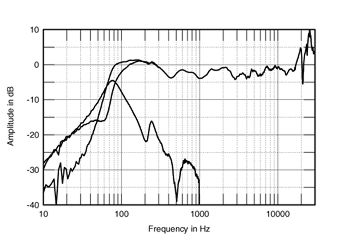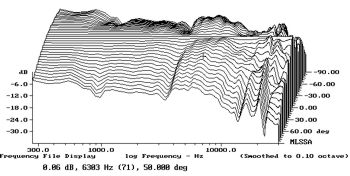| Columns Retired Columns & Blogs |
Thiel PCS loudspeaker Measurements
Sidebar 3: Measurements
To judge from his speaker designs---all of which feature generally low impedances---Jim Thiel has no sympathy for amplifier designers. While not as demanding as some Thiel speakers, the PCS's impedance magnitude (fig.1) hovers between 4 and 6 ohms over most of the band, and drops to 3 ohms in the lower midrange. Note also the punishing combination of 4 ohms magnitude and 55 degrees capacitive phase angle at 120Hz. This is a speaker that needs to be driven by an amplifier rated into 2 ohms to give of its best. But at least that amplifier doesn't have to be very powerful; the PCS's B-weighted sensitivity comes in above average at an estimated 89.5dB/2.83V/m.

Fig.1 Thiel PCS, electrical impedance (solid) and phase (dashed). (2 ohms/vertical div.)
A couple of wrinkles in the impedance traces are worthy of comment. The one around 4kHz is presumably due to the mechanical crossover between the midrange cone and the tweeter dome, while the one at 26kHz is due to the tweeter dome's oil-can resonance. There is also a slight discontinuity just above 300Hz that might be associated with a cabinet resonance of some kind. Fig.2, a cumulative spectral-decay plot calculated from the output of an accelerometer fastened to the center of the cabinet sidewall, reveals that there are actually two strong modes present in this region.

Fig.2 Thiel PCS, cumulative spectral-decay plot calculated from the output of an accelerometer fastened to the cabinet sidewall. (MLS driving voltage to speaker, 7.55V; measurement bandwidth, 2kHz.)
The saddle in the impedance-magnitude trace at 65Hz indicates the tuning of the port, which in turn implies modest bass extension. The fact that the lower of the two impedance peaks is much higher in magnitude than the upper peak tends to suggest an overdamped reflex alignment, which can also be seen to the left of fig.3. The port output is lower in level than usual, and the woofer output doesn't recover below its minimum-motion frequency as expected. As a result, the PCS's low frequencies roll off below 80Hz, giving it a light balance. Fig.3 also reveals a resonant mode in the port output at 250Hz, the frequency of the lower of the two cabinet modes seen in fig.2, and there is a mild glitch in the nearfield woofer output at this frequency.

Fig.3 Thiel PCS, anechoic response on-axis at 50", averaged across 30 degrees horizontal window and corrected for microphone response, with the nearfield woofer and port responses and their complex sum plotted below 300Hz, 1kHz, and 300Hz, respectively.
Higher in frequency, the PCS's on-axis midrange and treble balance is basically flat. Though there are some mild peaks and dips evident in this graph, their audibility will probably be minimal. The PCS's treble appears to be better-behaved than that of the CS2.3 reviewed in January 1999, which uses a similar coaxial midrange-tweeter unit. The mid-treble does rise a little, though not enough to correlate with why I found the speaker's balance to be so critical in this region. This subjective effect was probably due more to the lateral dispersion (fig.4), which does show a flare at the bottom of the tweeter dome's passband. But note otherwise the very even spacing of the "contour lines" in this graph, which always correlates with precise, well-defined stereo imaging.

Fig.4 Thiel PCS, lateral response family at 50", normalized to response on tweeter axis, from back to front: differences in response 90 degrees-5 degrees off-axis, reference response, differences in response 5 degrees-90 degrees off-axis.
- Log in or register to post comments




































